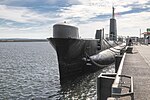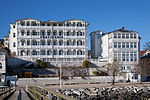Steinbach (Sassnitz)
Mecklenburg-Western Pomerania river stubsRivers of GermanyRivers of Mecklenburg-Western Pomerania

Steinbach is a small stream on the island of Rügen, Mecklenburg-Vorpommern, Germany. Its source is in the Jasmund National Park, and it flows into the Baltic Sea in the town of Sassnitz.
Excerpt from the Wikipedia article Steinbach (Sassnitz) (License: CC BY-SA 3.0, Authors, Images).Steinbach (Sassnitz)
Kurplatz,
Geographical coordinates (GPS) Address Nearby Places Show on map
Geographical coordinates (GPS)
| Latitude | Longitude |
|---|---|
| N 54.5167 ° | E 13.6565 ° |
Address
Kurplatz
Kurplatz
18546
Mecklenburg-Vorpommern, Germany
Open on Google Maps










